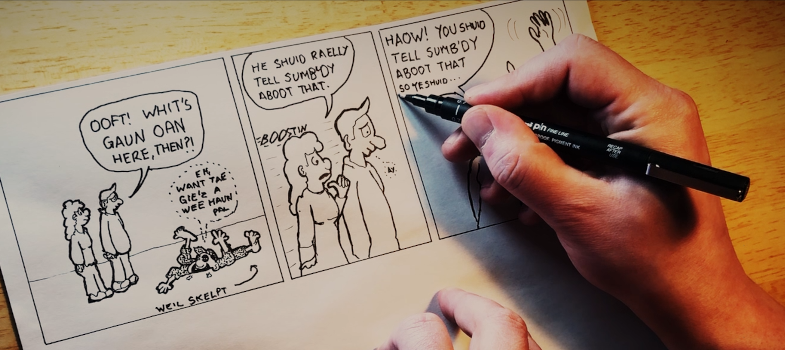Scots language in literature and creative writing

© Pauline Turner
8. Further Engagement
- Unit 19 Literature - Prose of the Open University Scots language and culture course by Alan Riach focuses on literary prose in Scots language and prose in Scots fiction. This will be a useful introduction to prose in Scots language literature.
- ScotsHoose is a fantastic resource for teaching Scots language to children. In particular, look at the 'screive' section for creative writing ideas and resources:
- The Scots Language Centre's 'Teaching Shakespeare, using Scots' is an inspirational blog by English teacher, Amy Douglas. This is also available on Glow Scotland.
- The Scottish Poetry Library has a large number of resources.
- The book 'Addressing the Bard: twelve contemporary poets respond to Robert Burns' (Gifford (ed), 2009) showcases old literary Scots alongside contemporary Scots and is a good teaching resource for language discussion. This resource is available online for free at Addressing the Bard.
- Traditional ghost stories told in modern Scots are a good stimulus for writing. Author, Alan Bissett, narrates some.
- In addition to the research you have engaged with, you can explore a research paper on creative writing in the English as a Foreign Language classroom, which takes account of the fact the writing is the most difficult skill to master in the English as a Foreign Language learning context. You will be able to see some similarities with teaching creative writing in Scots and might be able to pick up some useful teaching strategies from this paper, too. Access Esma Şenel’s paper: ‘The Integration of Creative Writing into Academic Writing Skills in EFL Classes’.
- Read a sociolinguistic study that highlights how Twitter users modulate how they use Scottish vocabulary depending on the audience they want to address with their tweets. Access the article 'Topic and audience effects on distinctively Scottish vocabulary usage in Twitter data' by Shoemark, Kirby and Goldwater.
